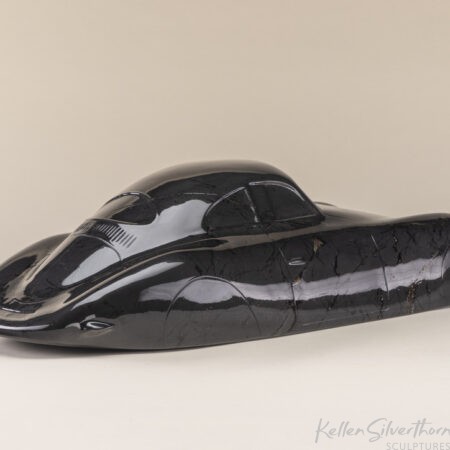When in Rome- inspired by the 1939 Porsche Type 64
Professor Ferdinand Porsche (1875-1951) was an extremely talented designer. How else could he be named Automotive Engineer of the Century, in 1999? The first model to carry the Porsche family name was the minimalist Type 64, prepared for the 1939 Berlin-to-Rome race.
Ferdinand Porsche’s life history can be claimed by the Czech, the Austrian, or the Germans. He always saw himself as Austrian. Born and raised in Bohemia (Czech), employment as a car designer took him to Vienna, and later Germany. With the Great Depression, industry jobs dried up, so he gathered a 19-member team of Austrians, and in 1931 set up an eponymous engineering consultancy at the heart of the German Auto Industry–Stuttgart.
Iconic designs from his teams’ engineering boards included: electric cars, aero engines, the wild V16 Auto Union single-seat racer, the Mercedes SS and SSK road warriors, as well as the humble VW Beetle. The “Professor” title was honorary, bestowed by several Universities….. his formal post-public education was in-fact rather limited. His designs, however, revealed his true genius.
Like any industrialist hoping to function in Nazi Germany of the 1930s, the Professor was involved with the Party. During the war years, he was also a prolific designer of weapons systems for their war effort.
The Professor spent several post-war years interned by the French for those wartime activities. By then, in his seventies, his health deteriorated while imprisoned. Failing health, dysfunctional international politics, and wrecked industrial infrastructure prevented Porsche Senior from working much magic post-war. He died in January, 1951 following a stroke during 1950.
It largely fell to the Professor’s son and engineering colleague “Ferry” to secure the future of what would become the Porsche sports car concern. Interestingly, this was achieved in then Soviet-controlled Austria, with the 47-unit production run of his pre-A 356 design in Gmund, spanning 1948-1950.
However, with retrospection there is an earlier Porsche sports car. Just before the outbreak of WWII the Professor and son Ferry generated the first branded Porsche, the Type 64, or alternately known as the 60K10. Three were made, and were intended to compete for a small displacement class victory in the heralded Berlin-Rome race of September 1939. Unfortunately, the German invasion of Poland in September, 1939 triggered WWII, and laid to rest both the race and the Type 64 competition plans.

Photo Credit topspeed.com
The Type 64s never realized their competition or marketing promise. WWII rendered them stillborn. Thus, most historians start the Porsche AG history in Gmund with the pre-A of 1948…… the Type 64 would be the proverbial tree that fell in the forest, that no one heard.

Photo Credit the Guardian
I would argue the Type 64 already embodies the primordial DNA of what later defined a Porsche sports car: aerodynamic, lightweight, rear-engine, air-cooled horizontally-opposed engine, simple, competition-intended. We can only wonder what the “lost decade” between the Type 64 and the pre-A Gmund would have produced, had WWII somehow been averted.

Photo Credit to motorauthority.com
The Type 64 greenhouse intentionally employed that of VW Type 38 / KdF / Beetle, while the remainder of the body was cribbed from a wind-tunnel-aided design for a V10 Sports Car (the Porsche Type 114, that never made it to production). Reutter coachworks handmade each of the three Type 64 bodies from aluminum sheet.

Photo Credit to motorauthority.com
The chassis for the Berlin-Rome cars were bespoke, and of period-aircraft construction techniques in aluminum. An air-cooled flat 4 engine of 1.0L, hung behind the rear transaxle.

Photo Credit to autoweek.com
Two of the three Type 64s remain in existence, though only one has uninterrupted provenance, including daily use by Ferry in the 1940s. That same car made more history in 2019, with an infamously botched auction drama. Indeed, the Type 64 story features all the intrigue of a Roman opera.
(Ferdinand’s grandson, and Ferry’s son, “Butzi” is credited with the design of the timeless Porsche 911. All three were actually named Ferdinand, so the nicknames “The Professor, Ferry, and Butzi are helpful to keep the three generations sorted.)
THE STONE
Swedish Graphite has become my go-to-choice for a silver-grey car. To me, pre-1965 Porsche competition cars should be silver in color. Graphite is forgiving to work with. It has great luster when clear-coated. Veining is fairly course, infrequent, and of a dull gold color.






